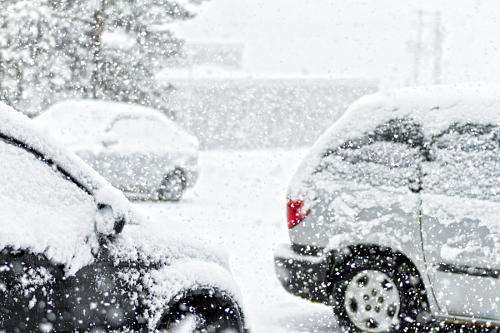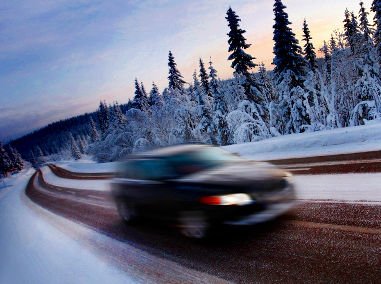Skills & strategies to be a safer, smarter driver.
00:00 - Safer, Smarter Winter Driving
07:36 - How to Recover From a Skid
11:38 - The Goofy People Stay Home in the Winter
13:09 - Why Intersections are Slippery in the Winter
15:43 - What is Over Steering?
17:27 - When are Winter Roads the Most Slippery?
23:39 - Rock the Vehicle to Get UnStuck
26:32 - Keep the Fuel Tank Above 1/2 Tank in the Winter
31:15 - Driving on Black Ice Safer
38:58 - Ford Mustang is Winter’s Safest Car
45:31 - Rear-End Crashes are the Most Common Collision in United States
50:02 - Driving in the Dark In the Winter is Challenging
54:55 - Look Up Reviews for Cars & Accessories
Closed Caption
Introduction
If you drive in the winter, you will die.
This message is shouted from every radio antenna during the winter months.
Thankfully, the message is false.

Fit your vehicle with good quality tires, and get the vehicle checked over.
Replace wiper blades.
Fill the washer reservoir with winter washer fluid.
Manage space well in front when driving.
Brake early, slow and then creep up to where you actually want to stop.
With these winter driving skills and strategies you will be a safer, smarter driver on snow and ice.
Most Slippery at Freezing
Roads in the winter are the most slippery when the temperature is at freezing (0°C or 32°F).
The reason is due to the fact that the ice and snow is freezing and thawing at this temperature.

This action creates a layer of water on top of the ice and it's the water that makes is slippery.
Think of the ice at a hockey rink after it's been flooded by the Zamboni.
The layer of water on top of the ice makes it slippery.
Friction from stopping cars at intersections makes it slippery because the heat melts the snow and ice.
Maintain a huge following distance so you have room to get your vehicle stopped safely in poor road conditions.
Get OUT of the Travelled Portion of the Road
Roadways are going to be the most slippery at intersections.
And yes, a roundabout is an intersection.
Slow down back from the intersection and then creep up to where you actually want to stop.
With this technique you'll actually get your vehicle stopped where you want it to stop.

If you are in a hurry or get caught out, and your vehicle isn't coming to a stop move to the outside of your lane to find traction.
Often if you get out of the main tracks where all the vehicles travel, you will find traction and get your vehicle stopped.
Travelling on the Highways
If you're travelling outside cities in the winter, you should fit your vehicle with a survival kit.
This kit will keep you safe in the event you become stranded in the ditch during a storm or there's an avalanche.
Your survival kit shoulder include prescription medications and a cell phone charger cable.
Tough to call for help if your cell phone's battery is dead.
There are other essential items that should go in your winter survival kit.
Get the full information by clicking the link above.

Recovering from a Skid
Over-steering, over-braking, or over-accelerating could cause you to lose control of your vehicle.
If your vehicle breaks traction, you could potentially lose control as your vehicle skids.
Too many drivers hit ice and then instinctively apply the brakes.
Applying the brakes often causes the tires to lock up.
Know that a locked or spinning wheel always leads.
In other words, the wheels that's either stopped or spinning is the direction the vehicle is going.
At this point, you've lost control.
With enough speed, you're probably going to crash.
To recover from a skid, take your foot off the accelerator and off the brake pedal.
Hopefully, when you got in the car, you fastened your seatbelt.
Not only does your seatbelt protect you in the event of a crash, it also keeps you in the driver's seat during an emergency maneuver.
To help staying in the driver's seat, you can post off the dead pedal - that's the pedal on the extreme left of the footwell where you usually rest your foot.
Focus on steering the vehicle in the direction you want it to go.
And to get the vehicle to go where you want it to go, you will probably have to steer like a crazy person.
LAST and most important: DON'T GIVE UP.
Too many drivers end up in the ditch or worse because they gave up.
Keep working until you get the vehicle stopped.
Where to find Ice in the Winter
There's no such thing as "black ice!"
It's just ice on the roadways.
It's irrelevant whether you can see it or not.
Moisture at night before the temperature drops below freezing are perfect conditions where you're going to find ice on the roadways.

Fog, melting snow and ice, and rain during the daytime will all lead to icy conditions the next day if the temperature dropped below freezing during the night.
Roads that have less traffic overnight too provide the conditions that will cause ice to form.
Think of it like a river.
Ice forms on the river where the water is slow and still; ice doesn't form on rapids where water is fast flowing.
Ice is most prevalent in the following locations:
1) bridges and overpasses;
2) anywhere the road lies in shadow (hills, buildings, or forests);
3) places where the road goes past a body of water;
4) low elevations;
5) high elevations.

Keep in mind that you're going to slide on ice in the early hours of the morning.
It's unusual to find the proverbial "black ice" during the day time.
And slippery ice on the roadway is going to be such when the temperature is around freezing (0°C or 32°F).
Slippery ice is such because there's a layer of water on top that acts like a lubricant.
If you get caught out on ice in the winter, take your foot off the brake and the accelerator and steer the vehicle in the direction you want it to go.



